Strategies for Improving Nursing Services for Domestic Abuse in the UK
VerifiedAdded on 2019/12/03
|9
|3585
|580
Essay
AI Summary
This essay delves into the issue of domestic abuse, focusing on the context of the United Kingdom and comparing it with India. It defines domestic violence, presents relevant statistics, and explores the role of nursing services in addressing the problem. The essay examines the historical shift in how domestic abuse has been viewed, from a social issue to a healthcare concern, and discusses the importance of clinical leadership and developed nursing services. It highlights the dimensions of providing supportive services to victims, including identification, assessment, documentation, safety planning, and referral. Furthermore, it explores the need for nurse training, empowerment, and the impact of nursing leadership in shaping health policy. The essay contrasts the roles and responsibilities of nurses in the UK and India, discussing training practices, professional bodies, and the use of mobile applications to combat domestic abuse. It concludes by emphasizing the greater responsibility and focus on nurse development in the UK compared to India.
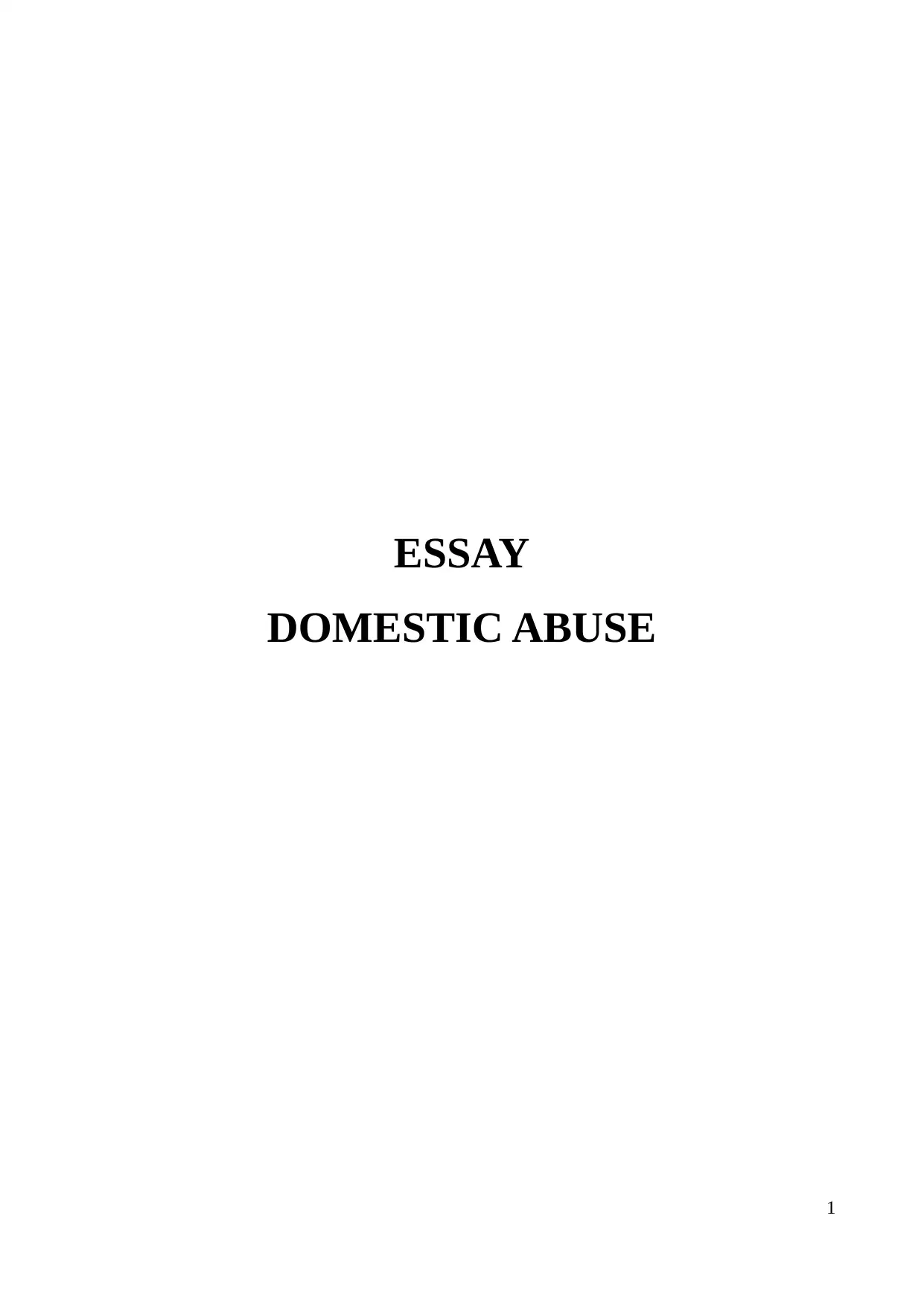
ESSAY
DOMESTIC ABUSE
1
DOMESTIC ABUSE
1
Paraphrase This Document
Need a fresh take? Get an instant paraphrase of this document with our AI Paraphraser
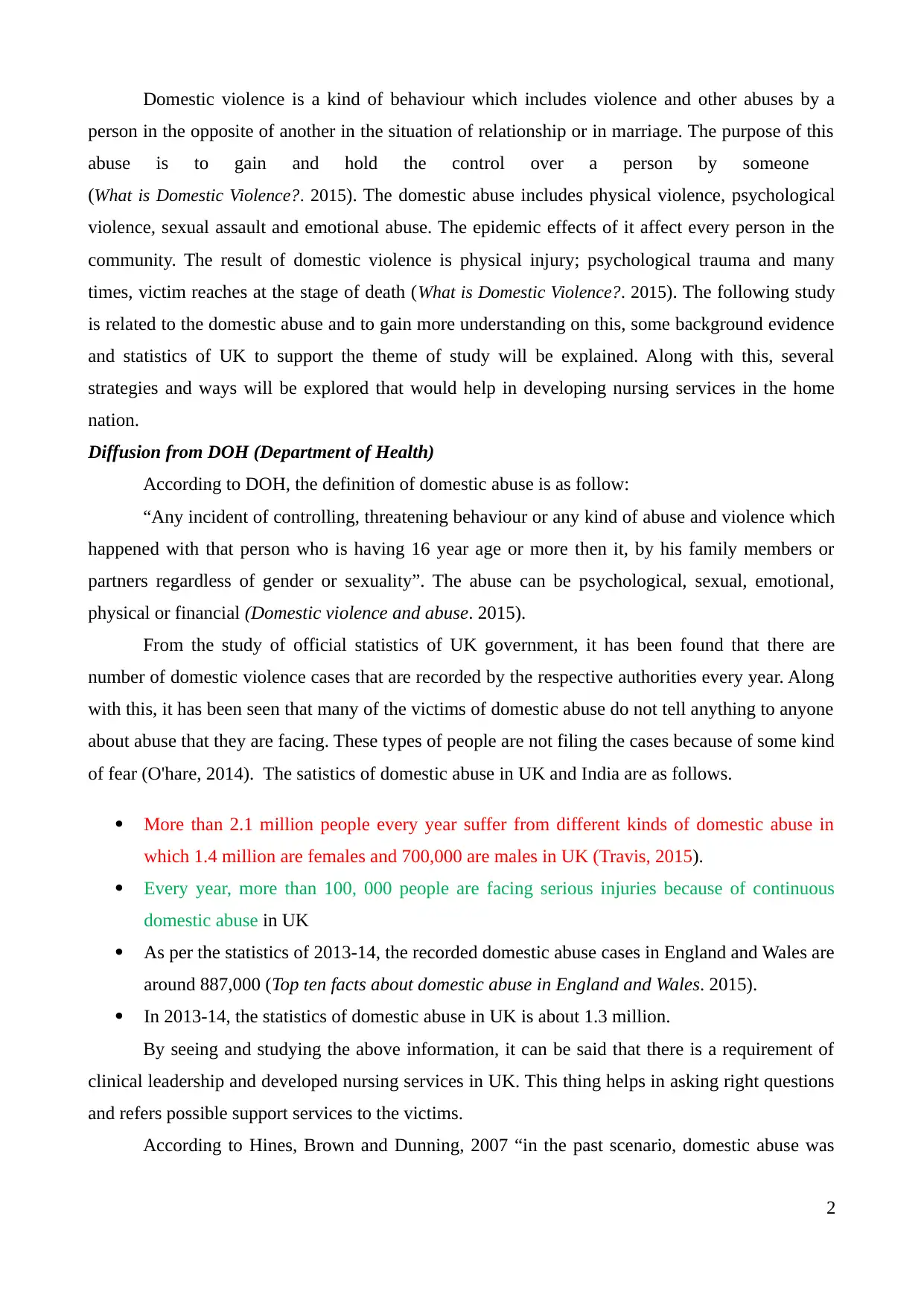
Domestic violence is a kind of behaviour which includes violence and other abuses by a
person in the opposite of another in the situation of relationship or in marriage. The purpose of this
abuse is to gain and hold the control over a person by someone
(What is Domestic Violence?. 2015). The domestic abuse includes physical violence, psychological
violence, sexual assault and emotional abuse. The epidemic effects of it affect every person in the
community. The result of domestic violence is physical injury; psychological trauma and many
times, victim reaches at the stage of death (What is Domestic Violence?. 2015). The following study
is related to the domestic abuse and to gain more understanding on this, some background evidence
and statistics of UK to support the theme of study will be explained. Along with this, several
strategies and ways will be explored that would help in developing nursing services in the home
nation.
Diffusion from DOH (Department of Health)
According to DOH, the definition of domestic abuse is as follow:
“Any incident of controlling, threatening behaviour or any kind of abuse and violence which
happened with that person who is having 16 year age or more then it, by his family members or
partners regardless of gender or sexuality”. The abuse can be psychological, sexual, emotional,
physical or financial (Domestic violence and abuse. 2015).
From the study of official statistics of UK government, it has been found that there are
number of domestic violence cases that are recorded by the respective authorities every year. Along
with this, it has been seen that many of the victims of domestic abuse do not tell anything to anyone
about abuse that they are facing. These types of people are not filing the cases because of some kind
of fear (O'hare, 2014). The satistics of domestic abuse in UK and India are as follows.
More than 2.1 million people every year suffer from different kinds of domestic abuse in
which 1.4 million are females and 700,000 are males in UK (Travis, 2015).
Every year, more than 100, 000 people are facing serious injuries because of continuous
domestic abuse in UK
As per the statistics of 2013-14, the recorded domestic abuse cases in England and Wales are
around 887,000 (Top ten facts about domestic abuse in England and Wales. 2015).
In 2013-14, the statistics of domestic abuse in UK is about 1.3 million.
By seeing and studying the above information, it can be said that there is a requirement of
clinical leadership and developed nursing services in UK. This thing helps in asking right questions
and refers possible support services to the victims.
According to Hines, Brown and Dunning, 2007 “in the past scenario, domestic abuse was
2
person in the opposite of another in the situation of relationship or in marriage. The purpose of this
abuse is to gain and hold the control over a person by someone
(What is Domestic Violence?. 2015). The domestic abuse includes physical violence, psychological
violence, sexual assault and emotional abuse. The epidemic effects of it affect every person in the
community. The result of domestic violence is physical injury; psychological trauma and many
times, victim reaches at the stage of death (What is Domestic Violence?. 2015). The following study
is related to the domestic abuse and to gain more understanding on this, some background evidence
and statistics of UK to support the theme of study will be explained. Along with this, several
strategies and ways will be explored that would help in developing nursing services in the home
nation.
Diffusion from DOH (Department of Health)
According to DOH, the definition of domestic abuse is as follow:
“Any incident of controlling, threatening behaviour or any kind of abuse and violence which
happened with that person who is having 16 year age or more then it, by his family members or
partners regardless of gender or sexuality”. The abuse can be psychological, sexual, emotional,
physical or financial (Domestic violence and abuse. 2015).
From the study of official statistics of UK government, it has been found that there are
number of domestic violence cases that are recorded by the respective authorities every year. Along
with this, it has been seen that many of the victims of domestic abuse do not tell anything to anyone
about abuse that they are facing. These types of people are not filing the cases because of some kind
of fear (O'hare, 2014). The satistics of domestic abuse in UK and India are as follows.
More than 2.1 million people every year suffer from different kinds of domestic abuse in
which 1.4 million are females and 700,000 are males in UK (Travis, 2015).
Every year, more than 100, 000 people are facing serious injuries because of continuous
domestic abuse in UK
As per the statistics of 2013-14, the recorded domestic abuse cases in England and Wales are
around 887,000 (Top ten facts about domestic abuse in England and Wales. 2015).
In 2013-14, the statistics of domestic abuse in UK is about 1.3 million.
By seeing and studying the above information, it can be said that there is a requirement of
clinical leadership and developed nursing services in UK. This thing helps in asking right questions
and refers possible support services to the victims.
According to Hines, Brown and Dunning, 2007 “in the past scenario, domestic abuse was
2
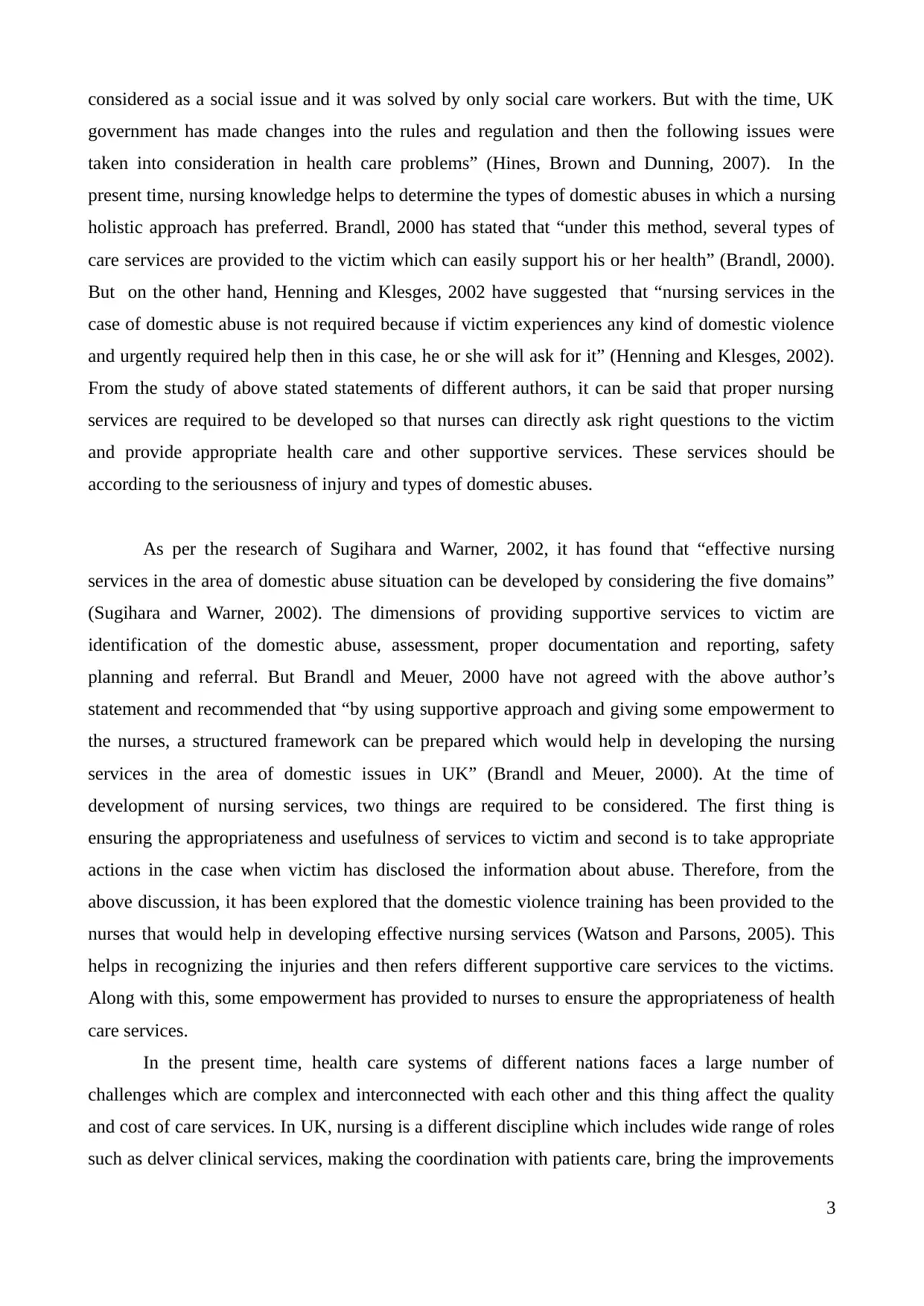
considered as a social issue and it was solved by only social care workers. But with the time, UK
government has made changes into the rules and regulation and then the following issues were
taken into consideration in health care problems” (Hines, Brown and Dunning, 2007). In the
present time, nursing knowledge helps to determine the types of domestic abuses in which a nursing
holistic approach has preferred. Brandl, 2000 has stated that “under this method, several types of
care services are provided to the victim which can easily support his or her health” (Brandl, 2000).
But on the other hand, Henning and Klesges, 2002 have suggested that “nursing services in the
case of domestic abuse is not required because if victim experiences any kind of domestic violence
and urgently required help then in this case, he or she will ask for it” (Henning and Klesges, 2002).
From the study of above stated statements of different authors, it can be said that proper nursing
services are required to be developed so that nurses can directly ask right questions to the victim
and provide appropriate health care and other supportive services. These services should be
according to the seriousness of injury and types of domestic abuses.
As per the research of Sugihara and Warner, 2002, it has found that “effective nursing
services in the area of domestic abuse situation can be developed by considering the five domains”
(Sugihara and Warner, 2002). The dimensions of providing supportive services to victim are
identification of the domestic abuse, assessment, proper documentation and reporting, safety
planning and referral. But Brandl and Meuer, 2000 have not agreed with the above author’s
statement and recommended that “by using supportive approach and giving some empowerment to
the nurses, a structured framework can be prepared which would help in developing the nursing
services in the area of domestic issues in UK” (Brandl and Meuer, 2000). At the time of
development of nursing services, two things are required to be considered. The first thing is
ensuring the appropriateness and usefulness of services to victim and second is to take appropriate
actions in the case when victim has disclosed the information about abuse. Therefore, from the
above discussion, it has been explored that the domestic violence training has been provided to the
nurses that would help in developing effective nursing services (Watson and Parsons, 2005). This
helps in recognizing the injuries and then refers different supportive care services to the victims.
Along with this, some empowerment has provided to nurses to ensure the appropriateness of health
care services.
In the present time, health care systems of different nations faces a large number of
challenges which are complex and interconnected with each other and this thing affect the quality
and cost of care services. In UK, nursing is a different discipline which includes wide range of roles
such as delver clinical services, making the coordination with patients care, bring the improvements
3
government has made changes into the rules and regulation and then the following issues were
taken into consideration in health care problems” (Hines, Brown and Dunning, 2007). In the
present time, nursing knowledge helps to determine the types of domestic abuses in which a nursing
holistic approach has preferred. Brandl, 2000 has stated that “under this method, several types of
care services are provided to the victim which can easily support his or her health” (Brandl, 2000).
But on the other hand, Henning and Klesges, 2002 have suggested that “nursing services in the
case of domestic abuse is not required because if victim experiences any kind of domestic violence
and urgently required help then in this case, he or she will ask for it” (Henning and Klesges, 2002).
From the study of above stated statements of different authors, it can be said that proper nursing
services are required to be developed so that nurses can directly ask right questions to the victim
and provide appropriate health care and other supportive services. These services should be
according to the seriousness of injury and types of domestic abuses.
As per the research of Sugihara and Warner, 2002, it has found that “effective nursing
services in the area of domestic abuse situation can be developed by considering the five domains”
(Sugihara and Warner, 2002). The dimensions of providing supportive services to victim are
identification of the domestic abuse, assessment, proper documentation and reporting, safety
planning and referral. But Brandl and Meuer, 2000 have not agreed with the above author’s
statement and recommended that “by using supportive approach and giving some empowerment to
the nurses, a structured framework can be prepared which would help in developing the nursing
services in the area of domestic issues in UK” (Brandl and Meuer, 2000). At the time of
development of nursing services, two things are required to be considered. The first thing is
ensuring the appropriateness and usefulness of services to victim and second is to take appropriate
actions in the case when victim has disclosed the information about abuse. Therefore, from the
above discussion, it has been explored that the domestic violence training has been provided to the
nurses that would help in developing effective nursing services (Watson and Parsons, 2005). This
helps in recognizing the injuries and then refers different supportive care services to the victims.
Along with this, some empowerment has provided to nurses to ensure the appropriateness of health
care services.
In the present time, health care systems of different nations faces a large number of
challenges which are complex and interconnected with each other and this thing affect the quality
and cost of care services. In UK, nursing is a different discipline which includes wide range of roles
such as delver clinical services, making the coordination with patients care, bring the improvements
3
⊘ This is a preview!⊘
Do you want full access?
Subscribe today to unlock all pages.

Trusted by 1+ million students worldwide
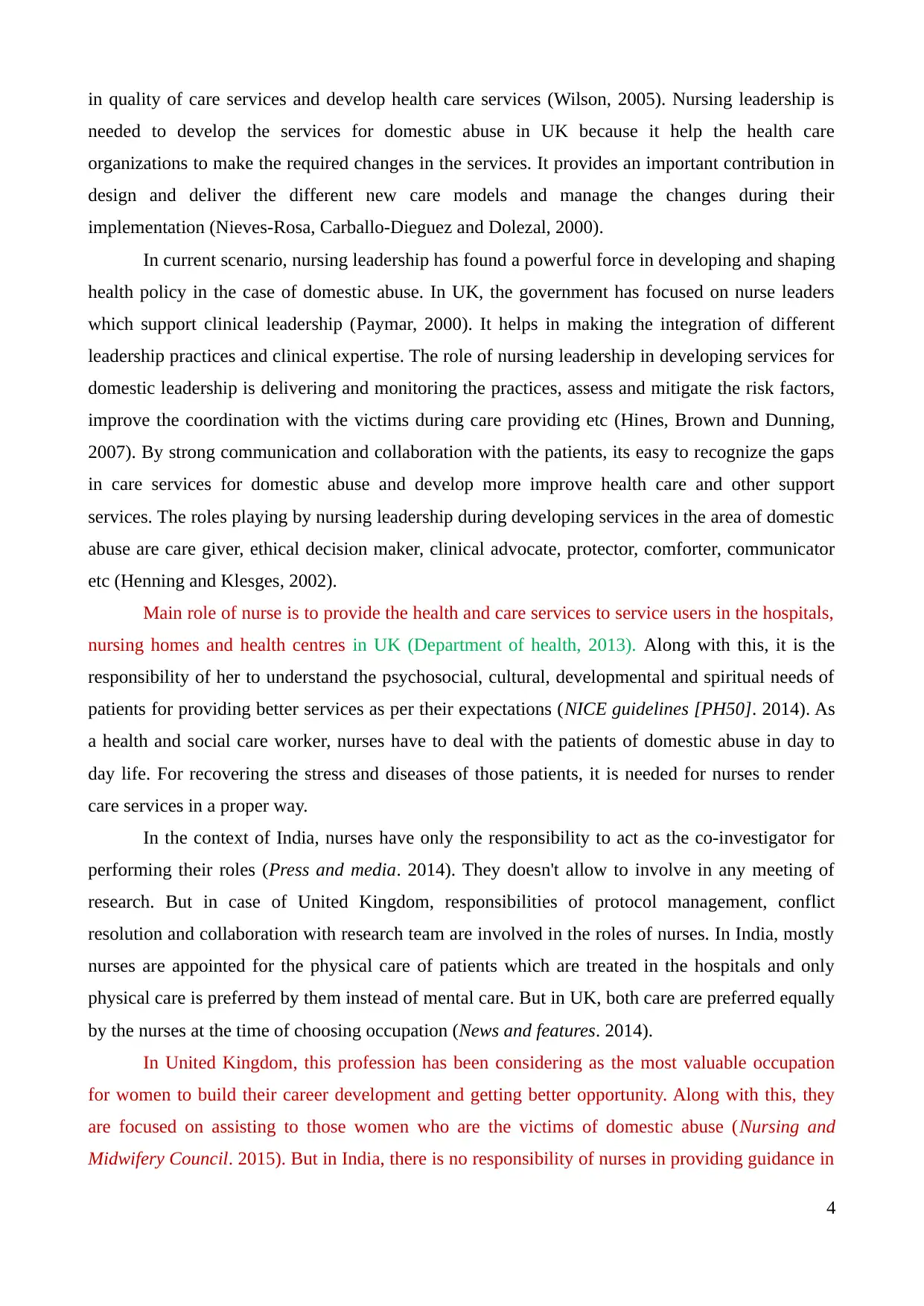
in quality of care services and develop health care services (Wilson, 2005). Nursing leadership is
needed to develop the services for domestic abuse in UK because it help the health care
organizations to make the required changes in the services. It provides an important contribution in
design and deliver the different new care models and manage the changes during their
implementation (Nieves-Rosa, Carballo-Dieguez and Dolezal, 2000).
In current scenario, nursing leadership has found a powerful force in developing and shaping
health policy in the case of domestic abuse. In UK, the government has focused on nurse leaders
which support clinical leadership (Paymar, 2000). It helps in making the integration of different
leadership practices and clinical expertise. The role of nursing leadership in developing services for
domestic leadership is delivering and monitoring the practices, assess and mitigate the risk factors,
improve the coordination with the victims during care providing etc (Hines, Brown and Dunning,
2007). By strong communication and collaboration with the patients, its easy to recognize the gaps
in care services for domestic abuse and develop more improve health care and other support
services. The roles playing by nursing leadership during developing services in the area of domestic
abuse are care giver, ethical decision maker, clinical advocate, protector, comforter, communicator
etc (Henning and Klesges, 2002).
Main role of nurse is to provide the health and care services to service users in the hospitals,
nursing homes and health centres in UK (Department of health, 2013). Along with this, it is the
responsibility of her to understand the psychosocial, cultural, developmental and spiritual needs of
patients for providing better services as per their expectations (NICE guidelines [PH50]. 2014). As
a health and social care worker, nurses have to deal with the patients of domestic abuse in day to
day life. For recovering the stress and diseases of those patients, it is needed for nurses to render
care services in a proper way.
In the context of India, nurses have only the responsibility to act as the co-investigator for
performing their roles (Press and media. 2014). They doesn't allow to involve in any meeting of
research. But in case of United Kingdom, responsibilities of protocol management, conflict
resolution and collaboration with research team are involved in the roles of nurses. In India, mostly
nurses are appointed for the physical care of patients which are treated in the hospitals and only
physical care is preferred by them instead of mental care. But in UK, both care are preferred equally
by the nurses at the time of choosing occupation (News and features. 2014).
In United Kingdom, this profession has been considering as the most valuable occupation
for women to build their career development and getting better opportunity. Along with this, they
are focused on assisting to those women who are the victims of domestic abuse (Nursing and
Midwifery Council. 2015). But in India, there is no responsibility of nurses in providing guidance in
4
needed to develop the services for domestic abuse in UK because it help the health care
organizations to make the required changes in the services. It provides an important contribution in
design and deliver the different new care models and manage the changes during their
implementation (Nieves-Rosa, Carballo-Dieguez and Dolezal, 2000).
In current scenario, nursing leadership has found a powerful force in developing and shaping
health policy in the case of domestic abuse. In UK, the government has focused on nurse leaders
which support clinical leadership (Paymar, 2000). It helps in making the integration of different
leadership practices and clinical expertise. The role of nursing leadership in developing services for
domestic leadership is delivering and monitoring the practices, assess and mitigate the risk factors,
improve the coordination with the victims during care providing etc (Hines, Brown and Dunning,
2007). By strong communication and collaboration with the patients, its easy to recognize the gaps
in care services for domestic abuse and develop more improve health care and other support
services. The roles playing by nursing leadership during developing services in the area of domestic
abuse are care giver, ethical decision maker, clinical advocate, protector, comforter, communicator
etc (Henning and Klesges, 2002).
Main role of nurse is to provide the health and care services to service users in the hospitals,
nursing homes and health centres in UK (Department of health, 2013). Along with this, it is the
responsibility of her to understand the psychosocial, cultural, developmental and spiritual needs of
patients for providing better services as per their expectations (NICE guidelines [PH50]. 2014). As
a health and social care worker, nurses have to deal with the patients of domestic abuse in day to
day life. For recovering the stress and diseases of those patients, it is needed for nurses to render
care services in a proper way.
In the context of India, nurses have only the responsibility to act as the co-investigator for
performing their roles (Press and media. 2014). They doesn't allow to involve in any meeting of
research. But in case of United Kingdom, responsibilities of protocol management, conflict
resolution and collaboration with research team are involved in the roles of nurses. In India, mostly
nurses are appointed for the physical care of patients which are treated in the hospitals and only
physical care is preferred by them instead of mental care. But in UK, both care are preferred equally
by the nurses at the time of choosing occupation (News and features. 2014).
In United Kingdom, this profession has been considering as the most valuable occupation
for women to build their career development and getting better opportunity. Along with this, they
are focused on assisting to those women who are the victims of domestic abuse (Nursing and
Midwifery Council. 2015). But in India, there is no responsibility of nurses in providing guidance in
4
Paraphrase This Document
Need a fresh take? Get an instant paraphrase of this document with our AI Paraphraser
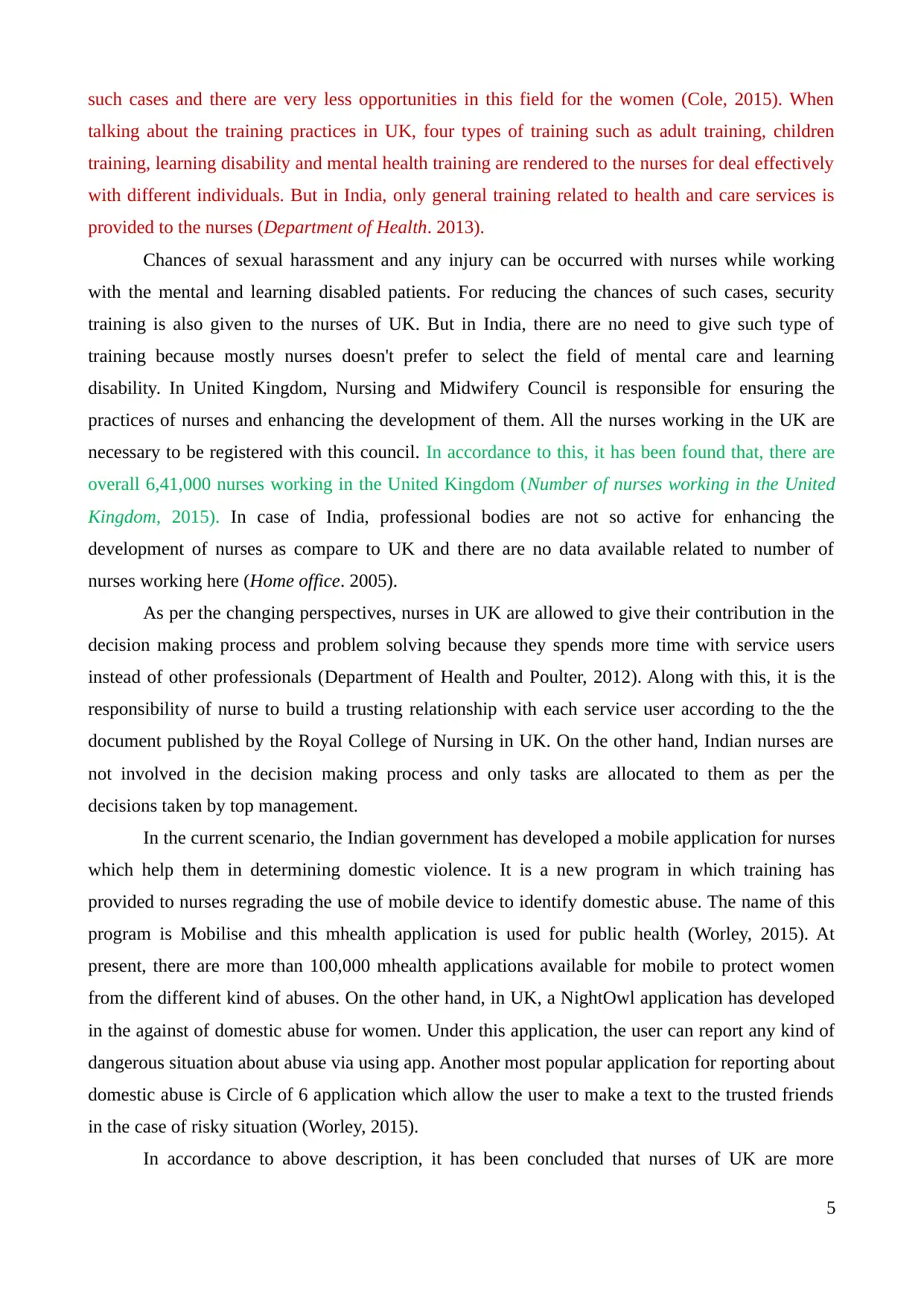
such cases and there are very less opportunities in this field for the women (Cole, 2015). When
talking about the training practices in UK, four types of training such as adult training, children
training, learning disability and mental health training are rendered to the nurses for deal effectively
with different individuals. But in India, only general training related to health and care services is
provided to the nurses (Department of Health. 2013).
Chances of sexual harassment and any injury can be occurred with nurses while working
with the mental and learning disabled patients. For reducing the chances of such cases, security
training is also given to the nurses of UK. But in India, there are no need to give such type of
training because mostly nurses doesn't prefer to select the field of mental care and learning
disability. In United Kingdom, Nursing and Midwifery Council is responsible for ensuring the
practices of nurses and enhancing the development of them. All the nurses working in the UK are
necessary to be registered with this council. In accordance to this, it has been found that, there are
overall 6,41,000 nurses working in the United Kingdom (Number of nurses working in the United
Kingdom, 2015). In case of India, professional bodies are not so active for enhancing the
development of nurses as compare to UK and there are no data available related to number of
nurses working here (Home office. 2005).
As per the changing perspectives, nurses in UK are allowed to give their contribution in the
decision making process and problem solving because they spends more time with service users
instead of other professionals (Department of Health and Poulter, 2012). Along with this, it is the
responsibility of nurse to build a trusting relationship with each service user according to the the
document published by the Royal College of Nursing in UK. On the other hand, Indian nurses are
not involved in the decision making process and only tasks are allocated to them as per the
decisions taken by top management.
In the current scenario, the Indian government has developed a mobile application for nurses
which help them in determining domestic violence. It is a new program in which training has
provided to nurses regrading the use of mobile device to identify domestic abuse. The name of this
program is Mobilise and this mhealth application is used for public health (Worley, 2015). At
present, there are more than 100,000 mhealth applications available for mobile to protect women
from the different kind of abuses. On the other hand, in UK, a NightOwl application has developed
in the against of domestic abuse for women. Under this application, the user can report any kind of
dangerous situation about abuse via using app. Another most popular application for reporting about
domestic abuse is Circle of 6 application which allow the user to make a text to the trusted friends
in the case of risky situation (Worley, 2015).
In accordance to above description, it has been concluded that nurses of UK are more
5
talking about the training practices in UK, four types of training such as adult training, children
training, learning disability and mental health training are rendered to the nurses for deal effectively
with different individuals. But in India, only general training related to health and care services is
provided to the nurses (Department of Health. 2013).
Chances of sexual harassment and any injury can be occurred with nurses while working
with the mental and learning disabled patients. For reducing the chances of such cases, security
training is also given to the nurses of UK. But in India, there are no need to give such type of
training because mostly nurses doesn't prefer to select the field of mental care and learning
disability. In United Kingdom, Nursing and Midwifery Council is responsible for ensuring the
practices of nurses and enhancing the development of them. All the nurses working in the UK are
necessary to be registered with this council. In accordance to this, it has been found that, there are
overall 6,41,000 nurses working in the United Kingdom (Number of nurses working in the United
Kingdom, 2015). In case of India, professional bodies are not so active for enhancing the
development of nurses as compare to UK and there are no data available related to number of
nurses working here (Home office. 2005).
As per the changing perspectives, nurses in UK are allowed to give their contribution in the
decision making process and problem solving because they spends more time with service users
instead of other professionals (Department of Health and Poulter, 2012). Along with this, it is the
responsibility of nurse to build a trusting relationship with each service user according to the the
document published by the Royal College of Nursing in UK. On the other hand, Indian nurses are
not involved in the decision making process and only tasks are allocated to them as per the
decisions taken by top management.
In the current scenario, the Indian government has developed a mobile application for nurses
which help them in determining domestic violence. It is a new program in which training has
provided to nurses regrading the use of mobile device to identify domestic abuse. The name of this
program is Mobilise and this mhealth application is used for public health (Worley, 2015). At
present, there are more than 100,000 mhealth applications available for mobile to protect women
from the different kind of abuses. On the other hand, in UK, a NightOwl application has developed
in the against of domestic abuse for women. Under this application, the user can report any kind of
dangerous situation about abuse via using app. Another most popular application for reporting about
domestic abuse is Circle of 6 application which allow the user to make a text to the trusted friends
in the case of risky situation (Worley, 2015).
In accordance to above description, it has been concluded that nurses of UK are more
5
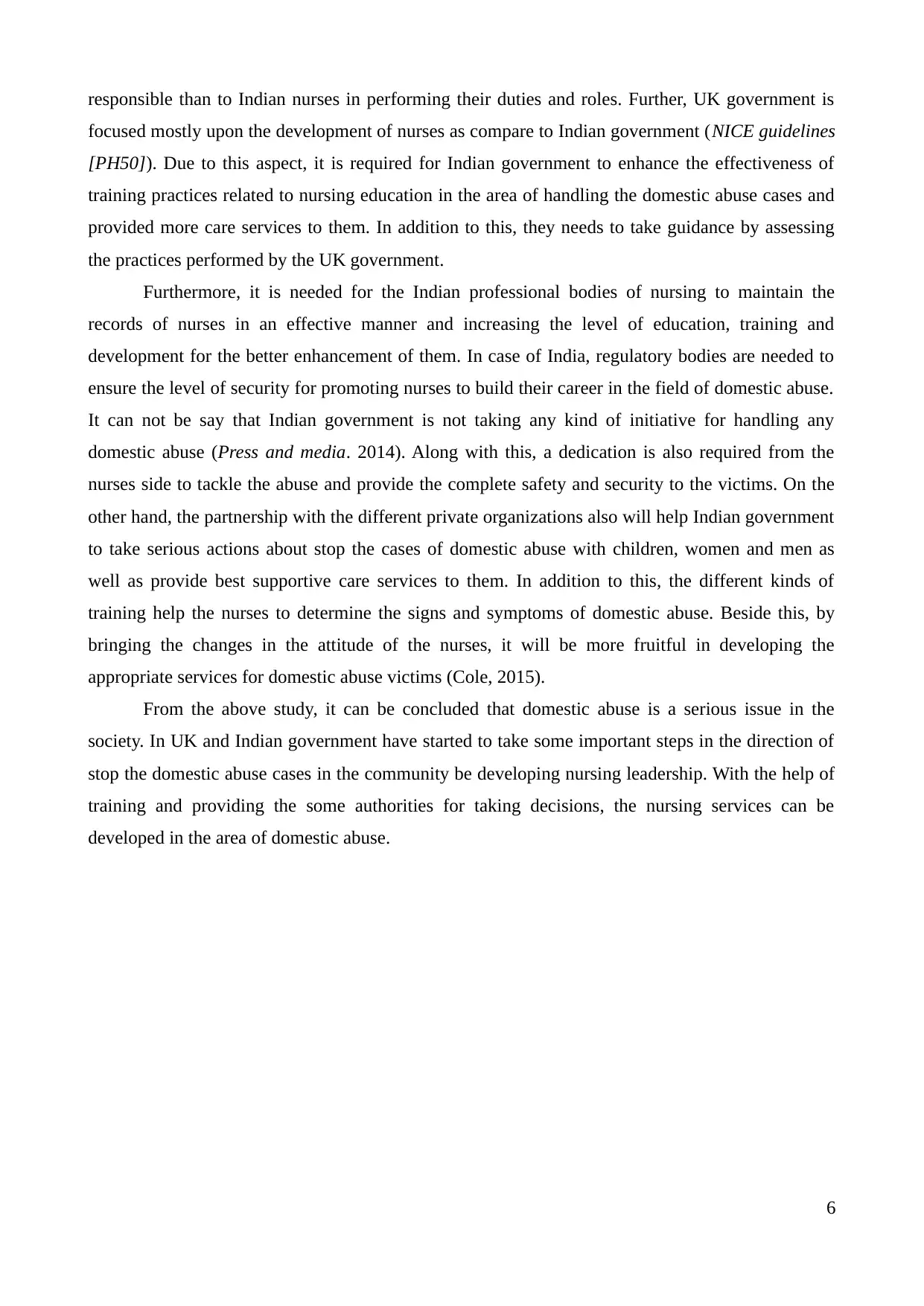
responsible than to Indian nurses in performing their duties and roles. Further, UK government is
focused mostly upon the development of nurses as compare to Indian government (NICE guidelines
[PH50]). Due to this aspect, it is required for Indian government to enhance the effectiveness of
training practices related to nursing education in the area of handling the domestic abuse cases and
provided more care services to them. In addition to this, they needs to take guidance by assessing
the practices performed by the UK government.
Furthermore, it is needed for the Indian professional bodies of nursing to maintain the
records of nurses in an effective manner and increasing the level of education, training and
development for the better enhancement of them. In case of India, regulatory bodies are needed to
ensure the level of security for promoting nurses to build their career in the field of domestic abuse.
It can not be say that Indian government is not taking any kind of initiative for handling any
domestic abuse (Press and media. 2014). Along with this, a dedication is also required from the
nurses side to tackle the abuse and provide the complete safety and security to the victims. On the
other hand, the partnership with the different private organizations also will help Indian government
to take serious actions about stop the cases of domestic abuse with children, women and men as
well as provide best supportive care services to them. In addition to this, the different kinds of
training help the nurses to determine the signs and symptoms of domestic abuse. Beside this, by
bringing the changes in the attitude of the nurses, it will be more fruitful in developing the
appropriate services for domestic abuse victims (Cole, 2015).
From the above study, it can be concluded that domestic abuse is a serious issue in the
society. In UK and Indian government have started to take some important steps in the direction of
stop the domestic abuse cases in the community be developing nursing leadership. With the help of
training and providing the some authorities for taking decisions, the nursing services can be
developed in the area of domestic abuse.
6
focused mostly upon the development of nurses as compare to Indian government (NICE guidelines
[PH50]). Due to this aspect, it is required for Indian government to enhance the effectiveness of
training practices related to nursing education in the area of handling the domestic abuse cases and
provided more care services to them. In addition to this, they needs to take guidance by assessing
the practices performed by the UK government.
Furthermore, it is needed for the Indian professional bodies of nursing to maintain the
records of nurses in an effective manner and increasing the level of education, training and
development for the better enhancement of them. In case of India, regulatory bodies are needed to
ensure the level of security for promoting nurses to build their career in the field of domestic abuse.
It can not be say that Indian government is not taking any kind of initiative for handling any
domestic abuse (Press and media. 2014). Along with this, a dedication is also required from the
nurses side to tackle the abuse and provide the complete safety and security to the victims. On the
other hand, the partnership with the different private organizations also will help Indian government
to take serious actions about stop the cases of domestic abuse with children, women and men as
well as provide best supportive care services to them. In addition to this, the different kinds of
training help the nurses to determine the signs and symptoms of domestic abuse. Beside this, by
bringing the changes in the attitude of the nurses, it will be more fruitful in developing the
appropriate services for domestic abuse victims (Cole, 2015).
From the above study, it can be concluded that domestic abuse is a serious issue in the
society. In UK and Indian government have started to take some important steps in the direction of
stop the domestic abuse cases in the community be developing nursing leadership. With the help of
training and providing the some authorities for taking decisions, the nursing services can be
developed in the area of domestic abuse.
6
⊘ This is a preview!⊘
Do you want full access?
Subscribe today to unlock all pages.

Trusted by 1+ million students worldwide
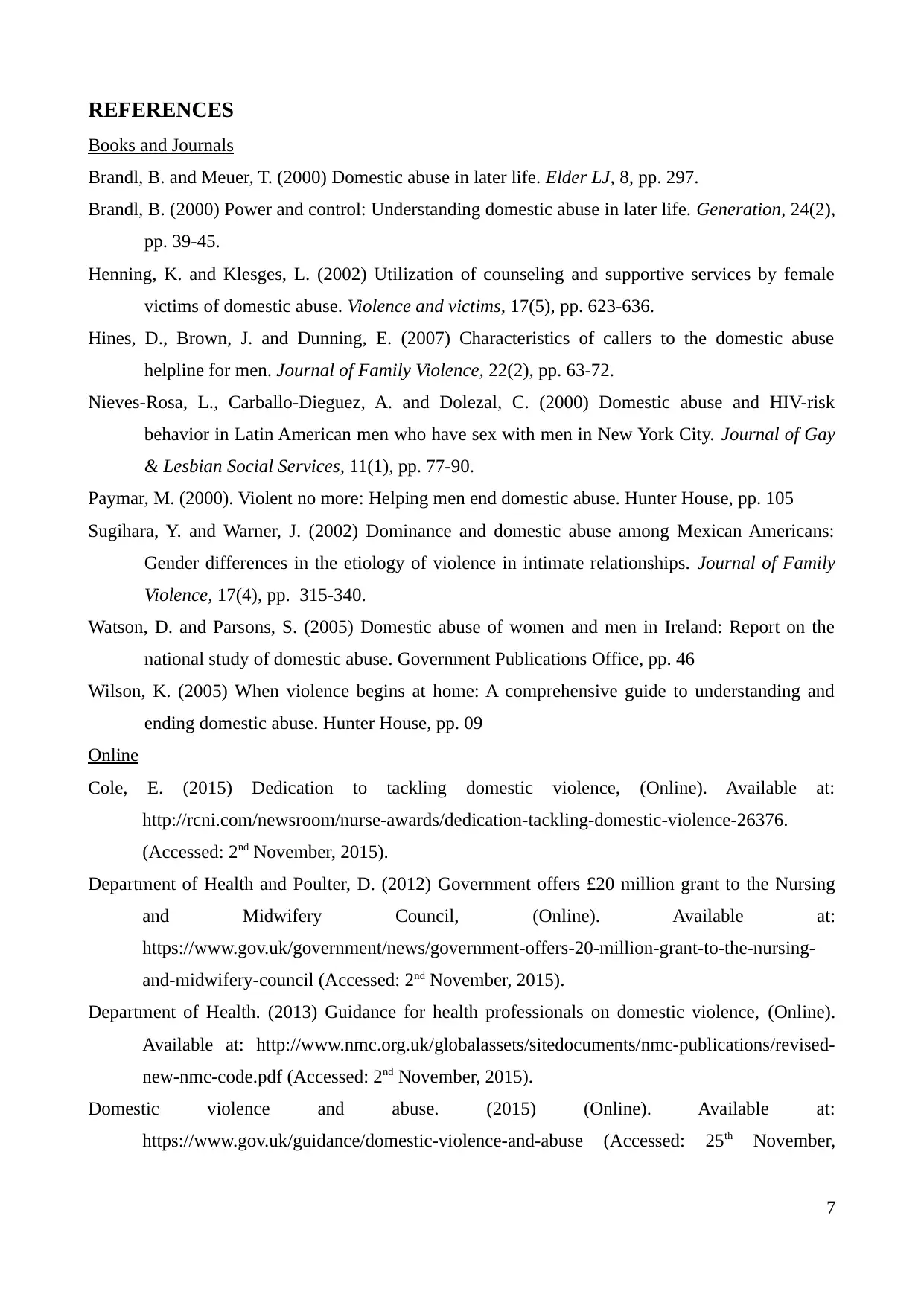
REFERENCES
Books and Journals
Brandl, B. and Meuer, T. (2000) Domestic abuse in later life. Elder LJ, 8, pp. 297.
Brandl, B. (2000) Power and control: Understanding domestic abuse in later life. Generation, 24(2),
pp. 39-45.
Henning, K. and Klesges, L. (2002) Utilization of counseling and supportive services by female
victims of domestic abuse. Violence and victims, 17(5), pp. 623-636.
Hines, D., Brown, J. and Dunning, E. (2007) Characteristics of callers to the domestic abuse
helpline for men. Journal of Family Violence, 22(2), pp. 63-72.
Nieves-Rosa, L., Carballo-Dieguez, A. and Dolezal, C. (2000) Domestic abuse and HIV-risk
behavior in Latin American men who have sex with men in New York City. Journal of Gay
& Lesbian Social Services, 11(1), pp. 77-90.
Paymar, M. (2000). Violent no more: Helping men end domestic abuse. Hunter House, pp. 105
Sugihara, Y. and Warner, J. (2002) Dominance and domestic abuse among Mexican Americans:
Gender differences in the etiology of violence in intimate relationships. Journal of Family
Violence, 17(4), pp. 315-340.
Watson, D. and Parsons, S. (2005) Domestic abuse of women and men in Ireland: Report on the
national study of domestic abuse. Government Publications Office, pp. 46
Wilson, K. (2005) When violence begins at home: A comprehensive guide to understanding and
ending domestic abuse. Hunter House, pp. 09
Online
Cole, E. (2015) Dedication to tackling domestic violence, (Online). Available at:
http://rcni.com/newsroom/nurse-awards/dedication-tackling-domestic-violence-26376.
(Accessed: 2nd November, 2015).
Department of Health and Poulter, D. (2012) Government offers £20 million grant to the Nursing
and Midwifery Council, (Online). Available at:
https://www.gov.uk/government/news/government-offers-20-million-grant-to-the-nursing-
and-midwifery-council (Accessed: 2nd November, 2015).
Department of Health. (2013) Guidance for health professionals on domestic violence, (Online).
Available at: http://www.nmc.org.uk/globalassets/sitedocuments/nmc-publications/revised-
new-nmc-code.pdf (Accessed: 2nd November, 2015).
Domestic violence and abuse. (2015) (Online). Available at:
https://www.gov.uk/guidance/domestic-violence-and-abuse (Accessed: 25th November,
7
Books and Journals
Brandl, B. and Meuer, T. (2000) Domestic abuse in later life. Elder LJ, 8, pp. 297.
Brandl, B. (2000) Power and control: Understanding domestic abuse in later life. Generation, 24(2),
pp. 39-45.
Henning, K. and Klesges, L. (2002) Utilization of counseling and supportive services by female
victims of domestic abuse. Violence and victims, 17(5), pp. 623-636.
Hines, D., Brown, J. and Dunning, E. (2007) Characteristics of callers to the domestic abuse
helpline for men. Journal of Family Violence, 22(2), pp. 63-72.
Nieves-Rosa, L., Carballo-Dieguez, A. and Dolezal, C. (2000) Domestic abuse and HIV-risk
behavior in Latin American men who have sex with men in New York City. Journal of Gay
& Lesbian Social Services, 11(1), pp. 77-90.
Paymar, M. (2000). Violent no more: Helping men end domestic abuse. Hunter House, pp. 105
Sugihara, Y. and Warner, J. (2002) Dominance and domestic abuse among Mexican Americans:
Gender differences in the etiology of violence in intimate relationships. Journal of Family
Violence, 17(4), pp. 315-340.
Watson, D. and Parsons, S. (2005) Domestic abuse of women and men in Ireland: Report on the
national study of domestic abuse. Government Publications Office, pp. 46
Wilson, K. (2005) When violence begins at home: A comprehensive guide to understanding and
ending domestic abuse. Hunter House, pp. 09
Online
Cole, E. (2015) Dedication to tackling domestic violence, (Online). Available at:
http://rcni.com/newsroom/nurse-awards/dedication-tackling-domestic-violence-26376.
(Accessed: 2nd November, 2015).
Department of Health and Poulter, D. (2012) Government offers £20 million grant to the Nursing
and Midwifery Council, (Online). Available at:
https://www.gov.uk/government/news/government-offers-20-million-grant-to-the-nursing-
and-midwifery-council (Accessed: 2nd November, 2015).
Department of Health. (2013) Guidance for health professionals on domestic violence, (Online).
Available at: http://www.nmc.org.uk/globalassets/sitedocuments/nmc-publications/revised-
new-nmc-code.pdf (Accessed: 2nd November, 2015).
Domestic violence and abuse. (2015) (Online). Available at:
https://www.gov.uk/guidance/domestic-violence-and-abuse (Accessed: 25th November,
7
Paraphrase This Document
Need a fresh take? Get an instant paraphrase of this document with our AI Paraphraser
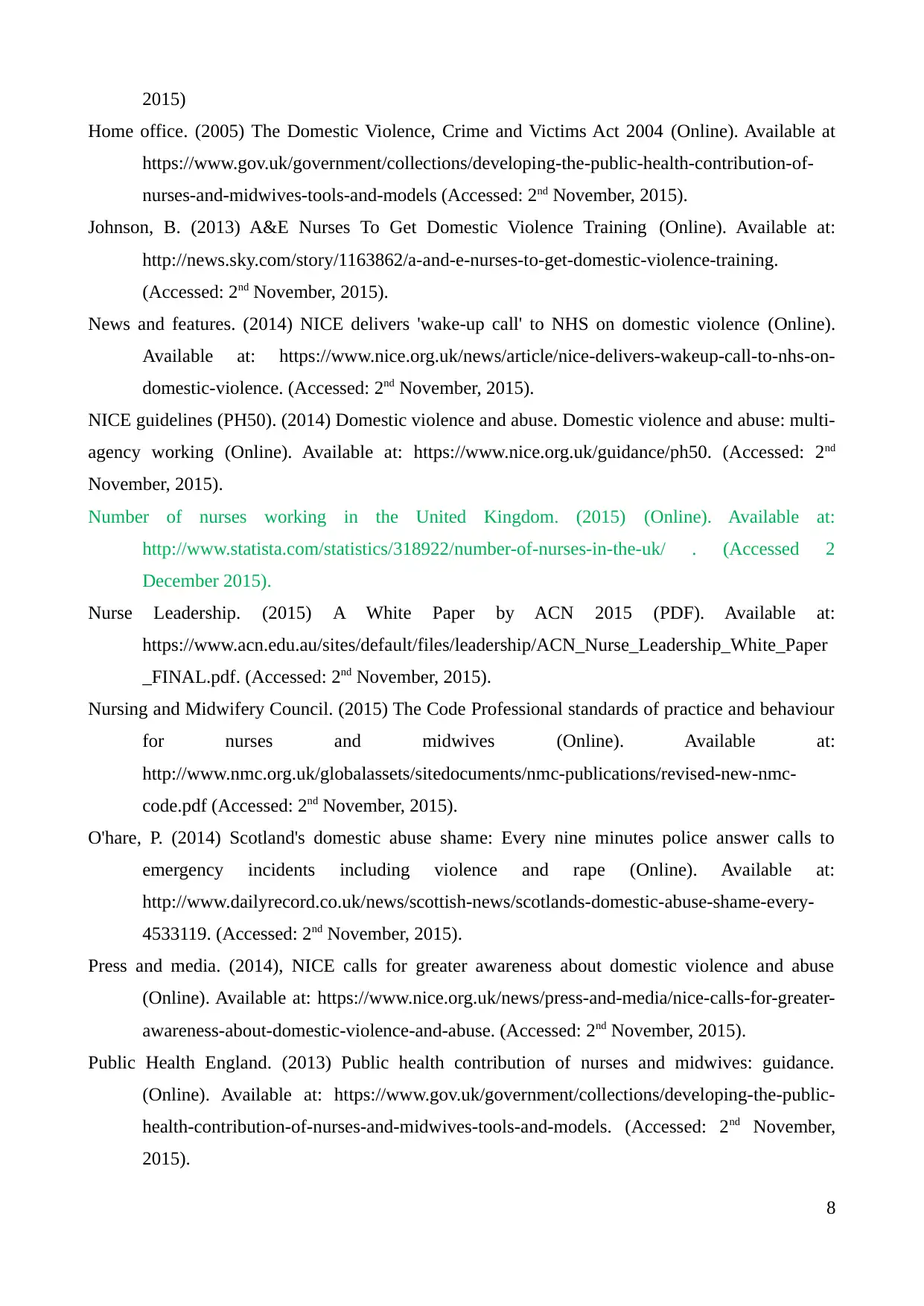
2015)
Home office. (2005) The Domestic Violence, Crime and Victims Act 2004 (Online). Available at
https://www.gov.uk/government/collections/developing-the-public-health-contribution-of-
nurses-and-midwives-tools-and-models (Accessed: 2nd November, 2015).
Johnson, B. (2013) A&E Nurses To Get Domestic Violence Training (Online). Available at:
http://news.sky.com/story/1163862/a-and-e-nurses-to-get-domestic-violence-training.
(Accessed: 2nd November, 2015).
News and features. (2014) NICE delivers 'wake-up call' to NHS on domestic violence (Online).
Available at: https://www.nice.org.uk/news/article/nice-delivers-wakeup-call-to-nhs-on-
domestic-violence. (Accessed: 2nd November, 2015).
NICE guidelines (PH50). (2014) Domestic violence and abuse. Domestic violence and abuse: multi-
agency working (Online). Available at: https://www.nice.org.uk/guidance/ph50. (Accessed: 2nd
November, 2015).
Number of nurses working in the United Kingdom. (2015) (Online). Available at:
http://www.statista.com/statistics/318922/number-of-nurses-in-the-uk/ . (Accessed 2
December 2015).
Nurse Leadership. (2015) A White Paper by ACN 2015 (PDF). Available at:
https://www.acn.edu.au/sites/default/files/leadership/ACN_Nurse_Leadership_White_Paper
_FINAL.pdf. (Accessed: 2nd November, 2015).
Nursing and Midwifery Council. (2015) The Code Professional standards of practice and behaviour
for nurses and midwives (Online). Available at:
http://www.nmc.org.uk/globalassets/sitedocuments/nmc-publications/revised-new-nmc-
code.pdf (Accessed: 2nd November, 2015).
O'hare, P. (2014) Scotland's domestic abuse shame: Every nine minutes police answer calls to
emergency incidents including violence and rape (Online). Available at:
http://www.dailyrecord.co.uk/news/scottish-news/scotlands-domestic-abuse-shame-every-
4533119. (Accessed: 2nd November, 2015).
Press and media. (2014), NICE calls for greater awareness about domestic violence and abuse
(Online). Available at: https://www.nice.org.uk/news/press-and-media/nice-calls-for-greater-
awareness-about-domestic-violence-and-abuse. (Accessed: 2nd November, 2015).
Public Health England. (2013) Public health contribution of nurses and midwives: guidance.
(Online). Available at: https://www.gov.uk/government/collections/developing-the-public-
health-contribution-of-nurses-and-midwives-tools-and-models. (Accessed: 2nd November,
2015).
8
Home office. (2005) The Domestic Violence, Crime and Victims Act 2004 (Online). Available at
https://www.gov.uk/government/collections/developing-the-public-health-contribution-of-
nurses-and-midwives-tools-and-models (Accessed: 2nd November, 2015).
Johnson, B. (2013) A&E Nurses To Get Domestic Violence Training (Online). Available at:
http://news.sky.com/story/1163862/a-and-e-nurses-to-get-domestic-violence-training.
(Accessed: 2nd November, 2015).
News and features. (2014) NICE delivers 'wake-up call' to NHS on domestic violence (Online).
Available at: https://www.nice.org.uk/news/article/nice-delivers-wakeup-call-to-nhs-on-
domestic-violence. (Accessed: 2nd November, 2015).
NICE guidelines (PH50). (2014) Domestic violence and abuse. Domestic violence and abuse: multi-
agency working (Online). Available at: https://www.nice.org.uk/guidance/ph50. (Accessed: 2nd
November, 2015).
Number of nurses working in the United Kingdom. (2015) (Online). Available at:
http://www.statista.com/statistics/318922/number-of-nurses-in-the-uk/ . (Accessed 2
December 2015).
Nurse Leadership. (2015) A White Paper by ACN 2015 (PDF). Available at:
https://www.acn.edu.au/sites/default/files/leadership/ACN_Nurse_Leadership_White_Paper
_FINAL.pdf. (Accessed: 2nd November, 2015).
Nursing and Midwifery Council. (2015) The Code Professional standards of practice and behaviour
for nurses and midwives (Online). Available at:
http://www.nmc.org.uk/globalassets/sitedocuments/nmc-publications/revised-new-nmc-
code.pdf (Accessed: 2nd November, 2015).
O'hare, P. (2014) Scotland's domestic abuse shame: Every nine minutes police answer calls to
emergency incidents including violence and rape (Online). Available at:
http://www.dailyrecord.co.uk/news/scottish-news/scotlands-domestic-abuse-shame-every-
4533119. (Accessed: 2nd November, 2015).
Press and media. (2014), NICE calls for greater awareness about domestic violence and abuse
(Online). Available at: https://www.nice.org.uk/news/press-and-media/nice-calls-for-greater-
awareness-about-domestic-violence-and-abuse. (Accessed: 2nd November, 2015).
Public Health England. (2013) Public health contribution of nurses and midwives: guidance.
(Online). Available at: https://www.gov.uk/government/collections/developing-the-public-
health-contribution-of-nurses-and-midwives-tools-and-models. (Accessed: 2nd November,
2015).
8
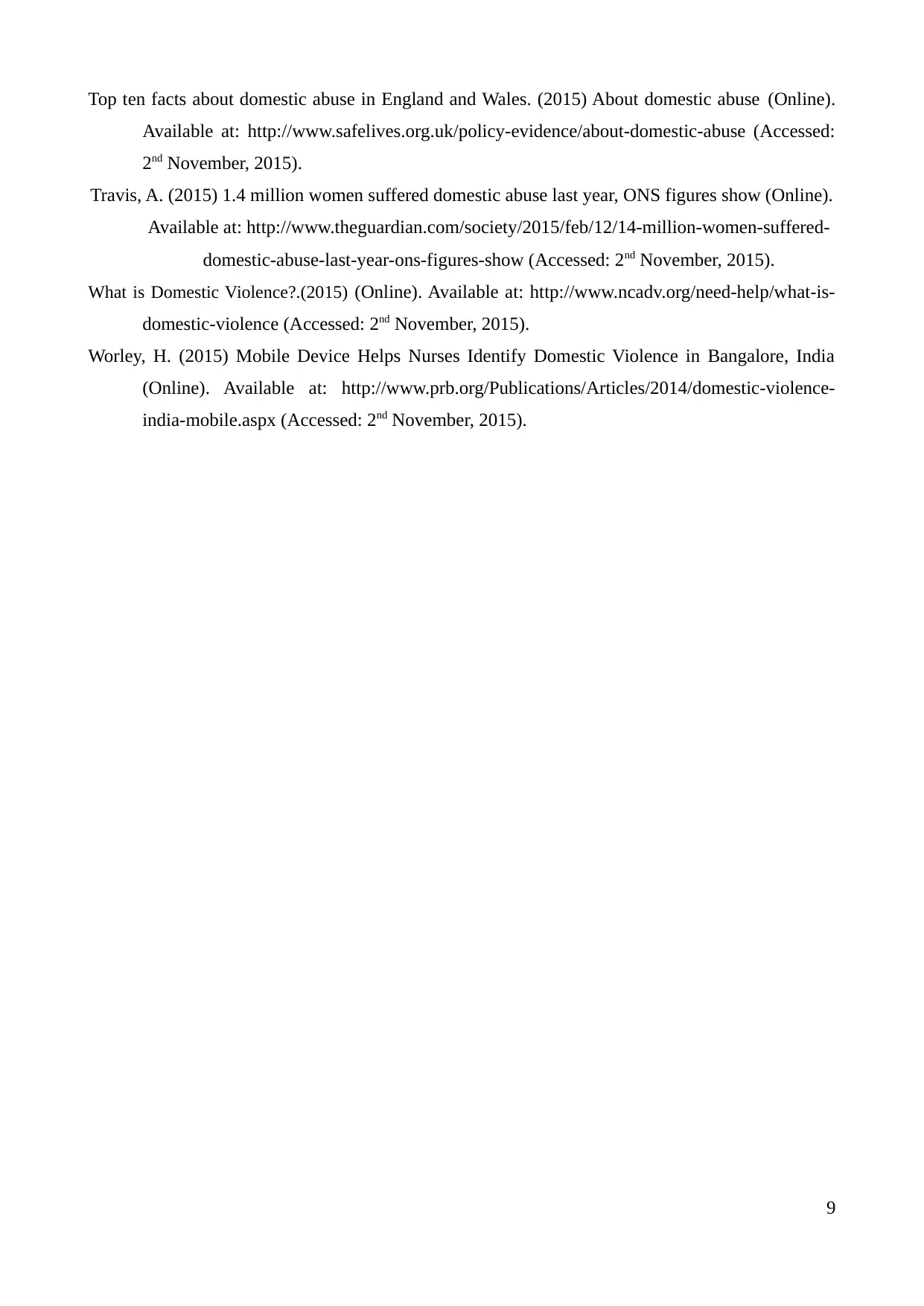
Top ten facts about domestic abuse in England and Wales. (2015) About domestic abuse (Online).
Available at: http://www.safelives.org.uk/policy-evidence/about-domestic-abuse (Accessed:
2nd November, 2015).
Travis, A. (2015) 1.4 million women suffered domestic abuse last year, ONS figures show (Online).
Available at: http://www.theguardian.com/society/2015/feb/12/14-million-women-suffered-
domestic-abuse-last-year-ons-figures-show (Accessed: 2nd November, 2015).
What is Domestic Violence?.(2015) (Online). Available at: http://www.ncadv.org/need-help/what-is-
domestic-violence (Accessed: 2nd November, 2015).
Worley, H. (2015) Mobile Device Helps Nurses Identify Domestic Violence in Bangalore, India
(Online). Available at: http://www.prb.org/Publications/Articles/2014/domestic-violence-
india-mobile.aspx (Accessed: 2nd November, 2015).
9
Available at: http://www.safelives.org.uk/policy-evidence/about-domestic-abuse (Accessed:
2nd November, 2015).
Travis, A. (2015) 1.4 million women suffered domestic abuse last year, ONS figures show (Online).
Available at: http://www.theguardian.com/society/2015/feb/12/14-million-women-suffered-
domestic-abuse-last-year-ons-figures-show (Accessed: 2nd November, 2015).
What is Domestic Violence?.(2015) (Online). Available at: http://www.ncadv.org/need-help/what-is-
domestic-violence (Accessed: 2nd November, 2015).
Worley, H. (2015) Mobile Device Helps Nurses Identify Domestic Violence in Bangalore, India
(Online). Available at: http://www.prb.org/Publications/Articles/2014/domestic-violence-
india-mobile.aspx (Accessed: 2nd November, 2015).
9
⊘ This is a preview!⊘
Do you want full access?
Subscribe today to unlock all pages.

Trusted by 1+ million students worldwide
1 out of 9
Related Documents
Your All-in-One AI-Powered Toolkit for Academic Success.
+13062052269
info@desklib.com
Available 24*7 on WhatsApp / Email
![[object Object]](/_next/static/media/star-bottom.7253800d.svg)
Unlock your academic potential
Copyright © 2020–2025 A2Z Services. All Rights Reserved. Developed and managed by ZUCOL.





